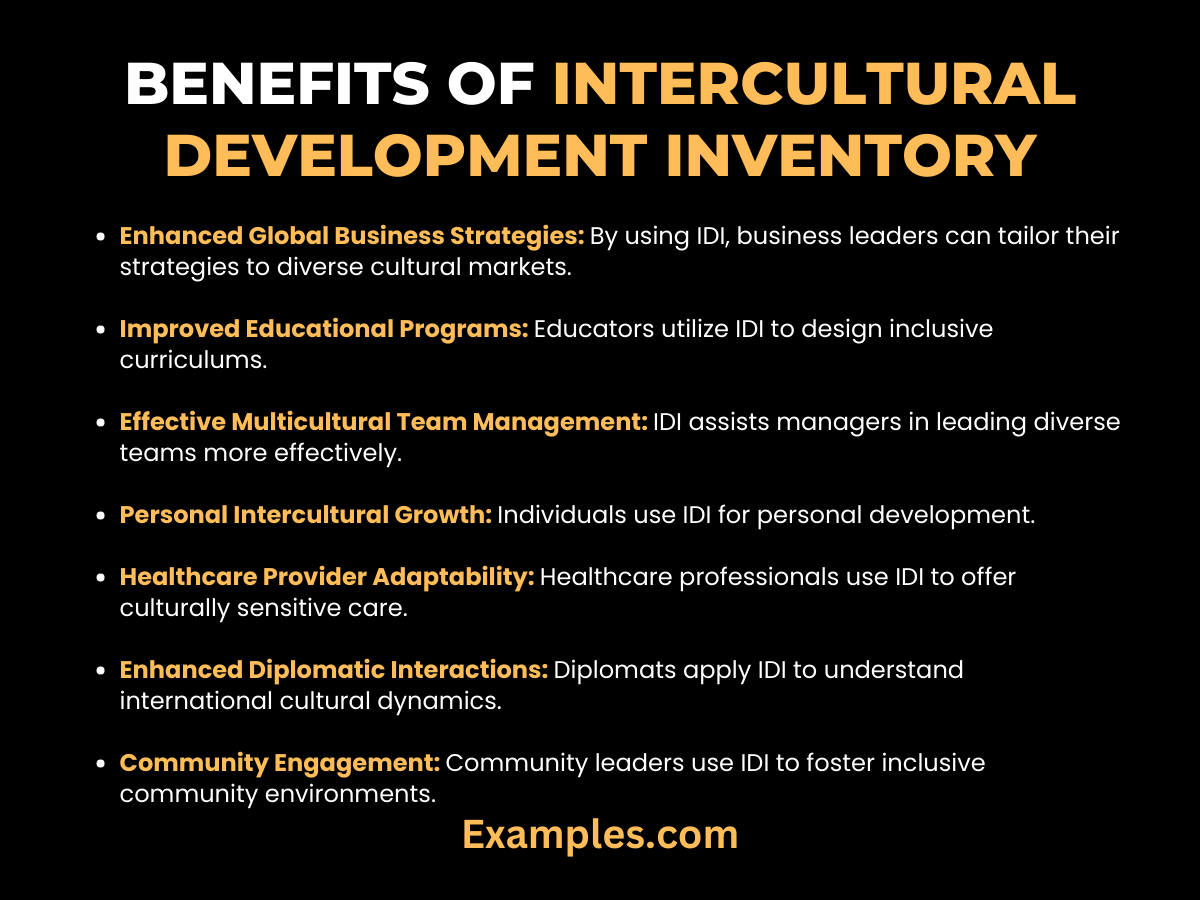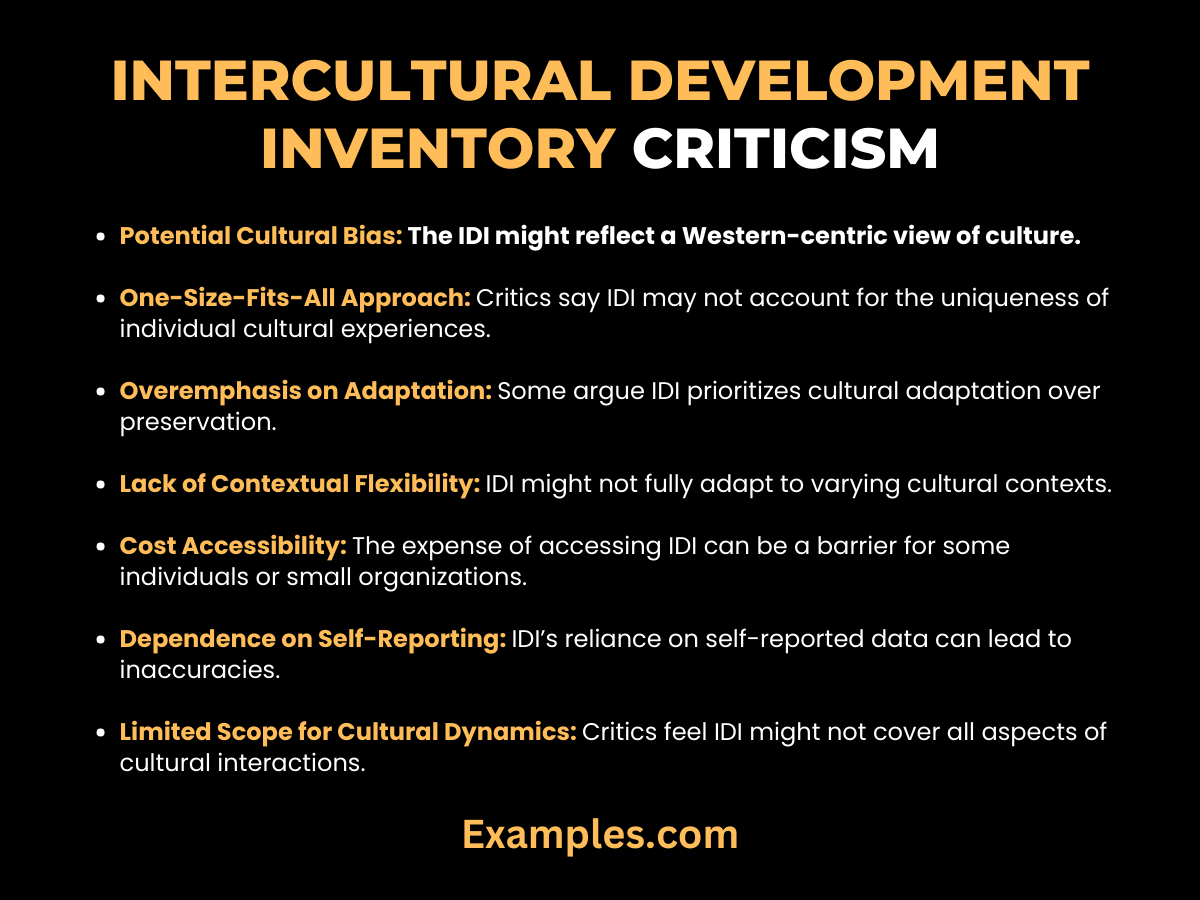9+ Intercultural Development Inventory Examples
Embark on a journey through the Intercultural Development Inventory (IDI), a comprehensive tool designed to enhance Intercultural Competency and communication. This guide delves into the IDI’s framework, offering practical insights and Intercultural Communication Examples. Whether you’re a professional, educator, or student, understanding the IDI paves the way for improved cultural interactions and enriched global connections. Discover how IDI can transform your approach to navigating the complexities of intercultural exchanges.
What is Intercultural Development Inventory?

The Intercultural Development Inventory (IDI) is a specialized assessment tool that measures an individual’s ability to understand and bridge cultural differences. It evaluates one’s intercultural awareness and competencies, providing insights into how effectively they can navigate and communicate across diverse cultural environments. Simply put, the IDI helps identify where a person stands in terms of understanding and responding to cultural diversity, and offers guidance for further development in intercultural communication skills.
10 Examples of Intercultural Development Inventory
Explore the diverse applications of the Intercultural Development Inventory (IDI) with these insightful examples. The IDI is a powerful tool used to assess and improve intercultural competencies in various settings. From enhancing global business strategies to fostering inclusive educational environments, these examples showcase how the IDI can be effectively utilized to navigate the complex landscape of intercultural communication. Understanding these examples is crucial for professionals and educators aiming to develop intercultural understanding and competence in today’s interconnected world.
1. Global Leadership Training Programs: Incorporating the IDI into leadership training to help leaders understand their intercultural strengths and areas for growth. This aids in developing strategies to lead diverse teams more effectively.
2. University Study Abroad Preparations: Using the IDI to prepare students for study abroad programs, helping them understand their own cultural biases and develop skills to adapt to new cultural environments.
3. Corporate Diversity and Inclusion Initiatives: Implementing the IDI in corporate settings to assess and improve employees’ intercultural competencies, fostering a more inclusive and understanding workplace environment.
4. Health Care Professionals’ Cultural Competence: Healthcare organizations using the IDI to assess and train staff in cultural competence, ensuring sensitive and effective patient care across cultures.
5. International Business Expansion Strategies: Companies entering new international markets use the IDI to understand cultural differences and develop effective cross-cultural business strategies.
6. Teacher Training for Multicultural Classrooms: Educators using the IDI to assess and improve their ability to teach in culturally diverse classrooms, enhancing student engagement and learning.
7. Non-Profit Organizations Working Internationally: Non-profits utilizing the IDI to prepare their staff for effective communication and collaboration in different cultural contexts, enhancing their global impact.
8. Government Diplomats’ Intercultural Training: Diplomats using the IDI to develop intercultural communication skills, crucial for navigating international relations and negotiations.
9. Cross-Cultural Customer Service Training: Customer service teams using the IDI to better understand and communicate with a diverse customer base, improving service quality and customer satisfaction.
10. International Marketing Teams: Marketing departments using the IDI to tailor their campaigns to diverse cultural audiences, ensuring relevance and effectiveness.
Benefits of Intercultural Development Inventory
The Intercultural Development Inventory (IDI) is an invaluable resource for enhancing Intercultural Communication Skills. It offers a structured approach to understanding and developing one’s intercultural competencies, crucial in today’s globalized environment. The IDI provides actionable insights, helping individuals and organizations navigate cultural complexities with greater awareness and efficiency.

- Enhanced Global Business Strategies: By using IDI, business leaders can tailor their strategies to diverse cultural markets.
Example: A manager adapts marketing campaigns to align with local cultural nuances, improving engagement and sales. - Improved Educational Programs: Educators utilize IDI to design inclusive curriculums.
Example: A university incorporates IDI feedback to create courses that reflect global cultural perspectives, enriching student learning. - Effective Multicultural Team Management: IDI assists managers in leading diverse teams more effectively.
Example: A team leader uses IDI insights to address communication gaps in a multicultural team, enhancing collaboration. - Personal Intercultural Growth: Individuals use IDI for personal development.
Example: A traveler applies IDI feedback to interact more respectfully and effectively with different cultures during their journeys. - Healthcare Provider Adaptability: Healthcare professionals use IDI to offer culturally sensitive care.
Example: A doctor adjusts their communication style to better connect with patients from diverse backgrounds, improving patient trust and care. - Enhanced Diplomatic Interactions: Diplomats apply IDI to understand international cultural dynamics.
Example: A diplomat leverages IDI insights to navigate complex negotiations with foreign counterparts more effectively. - Community Engagement: Community leaders use IDI to foster inclusive community environments.
Example: A community organizer implements IDI recommendations to plan culturally diverse and inclusive local events. - Corporate Training Efficiency: IDI improves cultural training programs in corporations.
Example: A corporate trainer integrates IDI into their curriculum, making cultural competence training more impactful. - Global Marketing Insights: Marketers use IDI to understand international consumer behavior.
Example: A marketing team applies IDI findings to create culturally relevant advertisements for different regions. - Conflict Resolution: IDI aids in resolving cultural misunderstandings.
Example: A mediator uses IDI to identify and address cultural conflicts in a diverse workplace setting.
Intercultural Development Inventory Criticism
While the Intercultural Development Inventory is a valuable tool, it faces criticism for potential biases and limitations. Critics argue that it may oversimplify complex cultural dynamics or rely too heavily on Western perspectives of intercultural competence.

- Potential Cultural Bias: The IDI might reflect a Western-centric view of culture.
Example: A user from a non-Western background finds some IDI assessments irrelevant to their cultural context, leading to skewed results. - One-Size-Fits-All Approach: Critics say IDI may not account for the uniqueness of individual cultural experiences.
Example: An IDI respondent feels the assessment doesn’t capture the nuances of their mixed cultural identity. - Overemphasis on Adaptation: Some argue IDI prioritizes cultural adaptation over preservation.
Example: A participant believes IDI suggestions encourage them to conform too much to other cultures, risking loss of their cultural identity. - Lack of Contextual Flexibility: IDI might not fully adapt to varying cultural contexts.
Example: A user in a multicultural society finds some IDI strategies less applicable in a highly diverse, fluid cultural environment. - Cost Accessibility: The expense of accessing IDI can be a barrier for some individuals or small organizations.
Example: A small NGO struggles to afford IDI assessments for its staff, limiting its accessibility. - Dependence on Self-Reporting: IDI’s reliance on self-reported data can lead to inaccuracies.
Example: A respondent’s lack of self-awareness leads to imprecise IDI results. - Limited Scope for Cultural Dynamics: Critics feel IDI might not cover all aspects of cultural interactions.
Example: A user finds IDI lacking in addressing specific cultural communication styles like high-context communication. - Questionable Validity in Diverse Settings: The validity of IDI in non-Western settings is sometimes questioned.
Example: A researcher challenges the applicability of IDI in predominantly Eastern cultural contexts. - Overgeneralization of Cultures: IDI might oversimplify the diversity within a single culture.
Example: An IDI participant feels their unique cultural practices are generalized or overlooked. - Insufficient Focus on Intercultural Skill Development: Some critics argue IDI focuses more on assessment than on developing practical skills.
Example: A professional seeks more actionable strategies from IDI for real-world intercultural engagement.
What is the Purpose of the Intercultural Development Inventory?
The Intercultural Development Inventory (IDI) serves a fundamental purpose in the realm of Intercultural Communication. It is a specialized assessment tool designed to evaluate and enhance intercultural competencies, both in individuals and groups. The IDI’s primary objective is to provide a clear framework for understanding and improving the way people communicate and interact across diverse cultural backgrounds.
Assessing Intercultural Competence
The IDI measures an individual’s or group’s primary orientation towards cultural differences and commonalities. It assesses where they fall on a spectrum of intercultural competence, ranging from monocultural mindsets to more interculturally adaptive mindsets. This assessment is crucial for identifying areas of strength and growth in dealing with cultural diversity.
Guiding Development and Training
By pinpointing specific developmental needs, the IDI guides personalized training programs and interventions. It helps in crafting strategies and methods tailored to enhance an individual’s or an organization’s ability to engage, communicate, and effectively operate in multicultural settings.
Enhancing Cultural Awareness and Sensitivity
The IDI fosters increased cultural awareness and sensitivity. It encourages individuals to reflect on their own cultural biases and perspectives, promoting a deeper understanding of how these factors influence their interactions with others from different cultures.
Facilitating Effective Communication
In contexts where Intercultural Communication is key, such as in global business, education, healthcare, and social services, the IDI serves as a vital tool. It helps individuals and teams to develop skills necessary for effective and respectful communication across cultural boundaries.
Promoting Inclusivity and Diversity
Organizations use the IDI to build more inclusive and diverse workplaces. By understanding and addressing the intercultural dynamics within their teams, organizations can create environments where diverse talents and perspectives are valued and leveraged.
Supporting Global Collaboration
In our interconnected world, the ability to navigate cultural differences is essential for successful global collaboration. The IDI aids individuals and organizations in developing the competencies needed to work effectively in international and cross-cultural settings.
In summary, the Intercultural Development Inventory plays a critical role in enhancing Intercultural Communication competencies. Its purpose extends beyond mere assessment – it is a comprehensive tool for growth, learning, and development in managing and appreciating cultural diversity effectively.



